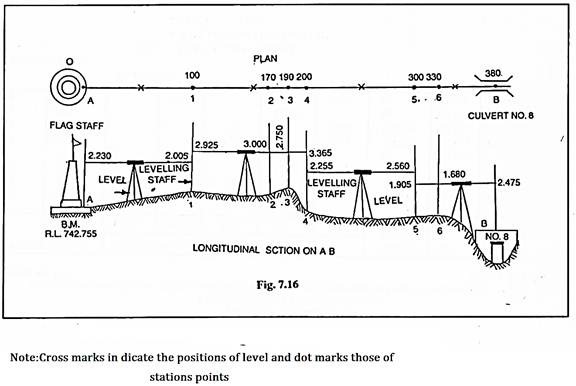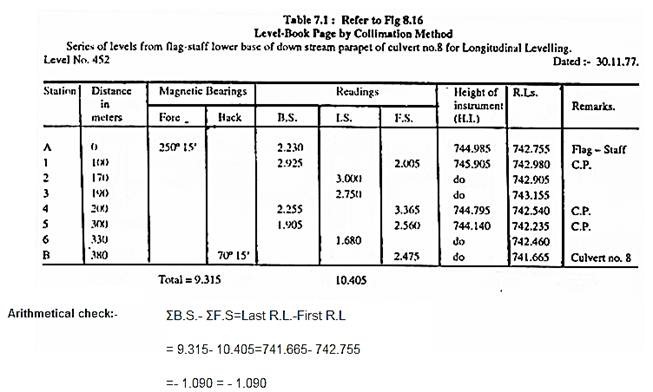There are two methods of working out the reduced levels of the point from the staff readings taken in the field: 1. Height of Instrument or Collimation Method. 2. Rise and Fall Method.
1. Collimation Method:
It consists in finding the elevation of the plane of collimation i.e. (H.I.) for every setting of the instrument and then obtaining the reduced levels of the points with reference to the respective plan of collimation
To start with, the H.L is calculated by adding the back sight of the R.L. of the starting point. The reduced levels of the intermediate point and the first change point are then obtained by subtracting the respective readings from the H.I. When the instrument is shifted, a new plane of collimation is set up and the height of which is calculated by adding back sight reading to the R.L. of the first change point.
The reduced levels of the successive points and the second change point arc found out by subtracting their staff readings from this new H.I. The process is repeated until all the R.Ls are worked out, and then the arithmetical check is applied.
ADVERTISEMENTS:
Arithmetical Check:
The difference between the sum of the back sights and the sum of the fore sights should be equal to the difference of the first and the last R.Ls i.e. Σ B.S. – Σ F.S. = Last R.L. -First R.L. This check verifies the calculation of R.Ls. of the planes of collimation and of the change points only. There is no check on the reduction of R.Ls. of the intermediate points.
This method may more clearly be understood by the following example of longitudinal levelling from flag – staff lower base to downstream parapet of culvert no. 8 . (Fig. 7.16).
ADVERTISEMENTS:
Entries are shown in Table 7.1.
2. Rise and Fall Method:
In this method, the difference between consecutive points is calculated by comparing each point after the first with that immediately preceding it. The difference of their staff reading indicates rise or fall according as any staff reading is smaller or greater than that at the preceding point. The R.L. of each point is then found by adding rise or subtracting fall to or from the R.L. of the preceding point.
ADVERTISEMENTS:
Remember:
If a staff reading (fore reading) is greater than that at the preceding point, then there is fall and if smaller then there is a rise.
Arithmetical Check:
ADVERTISEMENTS:
In this method, there are three checks on the accuracy of reduction of levels. The difference between the sum of the back sights and the sum of the fore sights is equal to the difference between the sum of the rises and that of the falls is equal to the difference between the first and the last R.Ls.
Σ B S. – Σ F.S. = Σ Rise – Σ fall = Last R.L. – Ist R.L.
This method is made clear by finding R.Ls. of the points in Fig. 7.16 in Table 7.2.
Comparison of the Collimation and Rise and Fall Methods of Reduction of Levels:
ADVERTISEMENTS:
Collimation Method:
1. In the case of more intermediate readings, there is considerable saving of labour and time as it involves only a few calculations.
2. There is no check on the R.Ls of intermediate stations.
3. There are two checks for arithmetical accuracy i.e. the difference between the sum of back sights of fore sights should be equal to the difference of the Ist and last R.Ls.
4. It is generally used for longitudinal and cross levelling operations and for giving levels of roads and canals and similar constructional works.
Rise and Fall Method:
1. It is a laborious method as staff reading of each point on the ground, after the first is compared with that preceding it, and the difference of level entered as a rise or fall.
2. There is a complete check on the reduction of R.Ls. of intermediate stations.
3. There are three checks for arithmetical accuracy. The difference between the sum of the back sights and the sum of the fore sights should be equal to that between the sum of the sum of rises and the sum of the falls as well as that between the Ist. and the last R.Ls.
4. It is generally used for earth work calculations and other precise levelling operations.
Booking the Staff Readings:
The following points should be kept in view while entering the staff readings in a level book:
1. The readings should be entered in the respective columns as soon as they are taken and in the order of their observation.
2. The first entry on the level book page is always a B.S and the last one a F.S.
3. The fore and back sights of the change points should be written in the same horizontal line.
4. The H.I should be written in the same horizontal line opposite the back sight.
5. While carrying forward the reading from one page of the level – book to the , if the last reading is an intermediate sight, it is entered in both I.S and F. S. column on this page and I.S. and B.S. columns as first entry on the page. The entries in the remaining columns against it should also be repeated on the page.
6. Brief description with neat sketches in respect of bench marks, change points and other important points should be given in the remark column.


